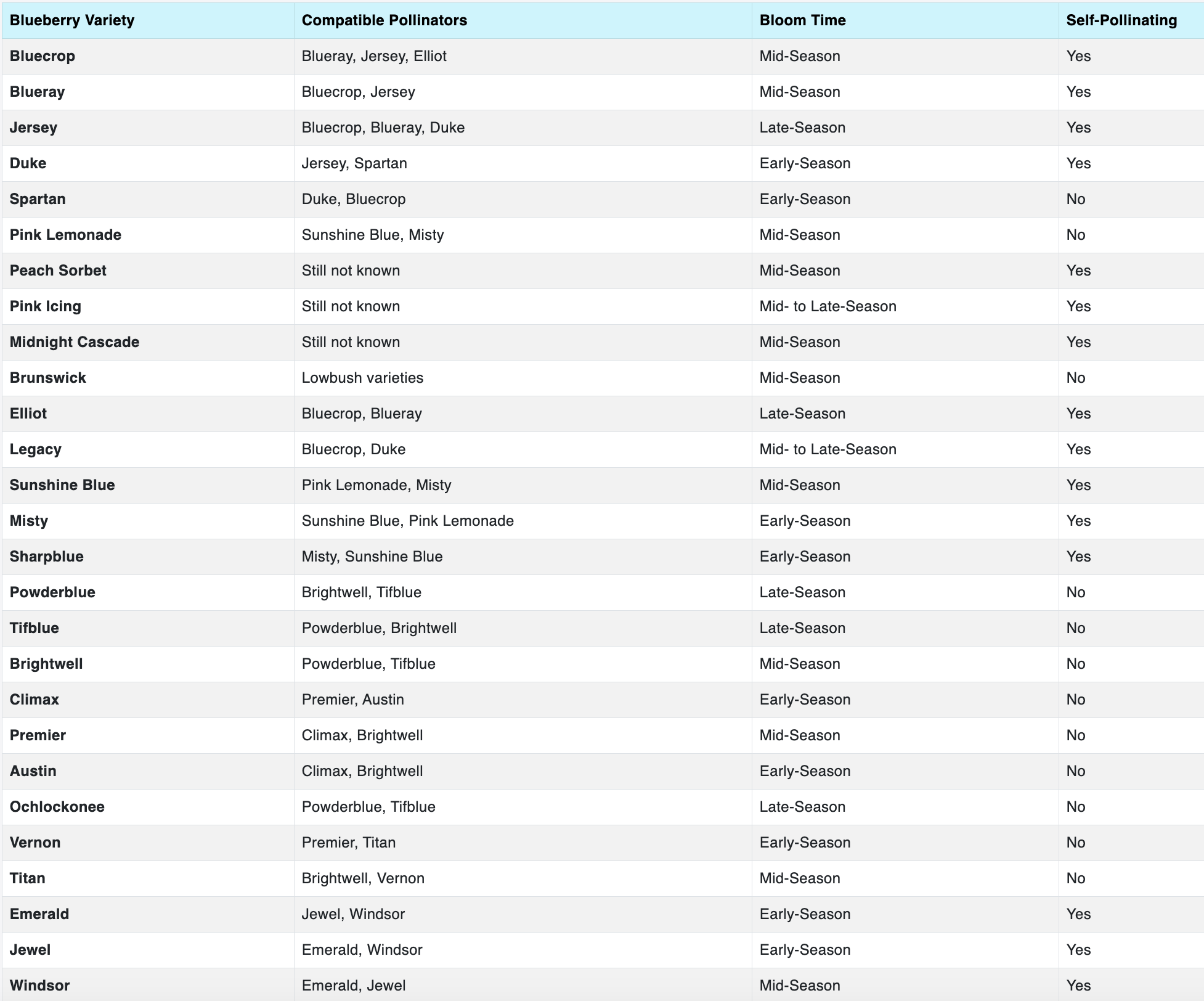
This is the ultimate guide on Blueberry cross pollination. In this article, you will find a visual blueberry cross-pollination chart that will include all the common varieties of blueberry and their best pollination partners.
Beside the chart, you will find these here:
- Do blueberries really need cross-pollination? and Benefits of cross-pollination over self-pollination
- Blueberry varieties based on USDA Zone.
- The main types of blueberry and why some varieties work better together
- Ideal pollination distance between plants
- And a lot more info that you will hardly find on the internet.
How did I gather all this information? We have been in blueberry cultivation for a long time and our family members love experimenting with blueberries. Gathering all the experiences, I am able to create this organized chart with other necessary information that you will love.
Let's start with the one you are looking for:
Cross pollination chart for Blueberry
I have cross-checked all the information in this table multiple times and this is why it took me a year to make this pollination chart.
To support me in bringing more charts like this, consider subscribing to this site (become a premium member).
| Blueberry Variety | Compatible Pollinators | Bloom Time | Self-Pollinating |
|---|---|---|---|
| Bluecrop | Blueray, Jersey, Elliot | Mid-Season | Yes |
| Blueray | Bluecrop, Jersey | Mid-Season | Yes |
| Jersey | Bluecrop, Blueray, Duke | Late-Season | Yes |
| Duke | Jersey, Spartan | Early-Season | Yes |
| Spartan | Duke, Bluecrop | Early-Season | No |
| Pink Lemonade | Sunshine Blue, Misty | Mid-Season | No |
| Peach Sorbet | Still not known | Mid-Season | Yes |
| Pink Icing | Still not known | Mid- to Late-Season | Yes |
| Midnight Cascade | Still not known | Mid-Season | Yes |
| Brunswick | Lowbush varieties | Mid-Season | No |
| Elliot | Bluecrop, Blueray | Late-Season | Yes |
| Legacy | Bluecrop, Duke | Mid- to Late-Season | Yes |
| Sunshine Blue | Pink Lemonade, Misty | Mid-Season | Yes |
| Misty | Sunshine Blue, Pink Lemonade | Early-Season | Yes |
| Sharpblue | Misty, Sunshine Blue | Early-Season | Yes |
| Powderblue | Brightwell, Tifblue | Late-Season | No |
| Tifblue | Powderblue, Brightwell | Late-Season | No |
| Brightwell | Powderblue, Tifblue | Mid-Season | No |
| Climax | Premier, Austin | Early-Season | No |
| Premier | Climax, Brightwell | Mid-Season | No |
| Austin | Climax, Brightwell | Early-Season | No |
| Ochlockonee | Powderblue, Tifblue | Late-Season | No |
| Vernon | Premier, Titan | Early-Season | No |
| Titan | Brightwell, Vernon | Mid-Season | No |
| Emerald | Jewel, Windsor | Early-Season | Yes |
| Jewel | Emerald, Windsor | Early-Season | Yes |
| Windsor | Emerald, Jewel | Mid-Season | Yes |
Legacy is technically a Northern-Southern hybrid.
If you want a printable PDF eBook you can get it from here:
Blueberry Pollination Chart with other useful charts - Printable eBook (Buy Now)
You will get all the charts in beautiful printable formats. You will also get the best planting time, watering, and sunlight requirements charts for specific blueberry varieties. You can say, all in a single place.
Bonus tip: For growing fruit trees, fertilizer is essential. I love making the organic fertilizer for my fruit trees at home. You can follow my guide: homemade fertilizer for fruit trees with chart.
Do blueberries really need cross-pollination?
As you can see, most of the blueberry varieties are self-pollinating. Still, we encourage cross-pollination. In this section, I will uncover all the doubts.
Cross-pollination can increase yield, berry size, and fruit quality. These are the major reasons we do love cross-pollination (Especially when we grow blueberries commercially)
Each blueberry flower contains both male (stamen) and female (stigma) parts (like a lot of other flowers in nature). These parts are enough to complete the self-pollination.
This is what happens when pollen comes from a different variety:
Larger berries – Cross-pollinated blueberries develop fuller, plumper fruit.
- Higher yields – More flowers turn into fruit when cross-pollinated.
- Better quality – Berries become juicier and more flavorful.
- Earlier ripening – Some varieties mature faster with cross-pollination.
Note: Try to follow the pollination chart. If you go with incompatible varieties, the blooming time might not overlap properly. If the chosen varieties aren’t good pollination partners, you may end up with smaller berries with bad yield.
Blueberry varieties to grow based on USDA zone
Not all the varieties are meant to grow in all the USDA zones.
To simplify things, I've created a small chart to help you determine which variety suits each USDA zone.
| USDA Zone | Suitable Blueberry Varieties |
|---|---|
| 3-4 | Northblue, Northcountry, Northsky, Chippewa, Polaris |
| 5-6 | Bluecrop, Blueray, Patriot, Duke, Jersey |
| 7-8 | Legacy, O’Neal, Sunshine Blue, Misty, Sharpblue |
| 9-10 | Jewel, Windsor, Emerald, Pink Icing, Peach Sorbet |
Consider their cold tolerance and grow them to their suitable growing zone.
The main types of blueberry and why some blueberry varieties work better together
Blueberries come in several types and they grow in different growing conditions.
Some blueberry varieties naturally perform better when planted nearby due to bloom time synchronization (blooming in the same season), genetic compatibility, and pollinator attraction (attracting the same pollinator insects).
We need to understand the different types of blueberries to master the pollination skill.
There are 5 major blueberry types and they are:
- Highbush Blueberries (Vaccinium corymbosum)
- Southern Highbush Blueberries
- Rabbiteye Blueberries (Vaccinium virgatum or V. ashei)
- Lowbush Blueberries (Vaccinium angustifolium)
- Half-High Blueberries (Hybrid of Highbush and Lowbush)
| Blueberry Type | Varieties |
|---|---|
| Highbush | Bluecrop, Jersey, Duke, Legacy, Elliott |
| Southern Highbush | Sunshine Blue, Misty, Emerald, Sharpblue, Jewel |
| Rabbiteye | Tifblue, Brightwell, Climax, Powderblue, Premier |
| Lowbush | Brunswick, Fundy, Top Hat, Wild Lowbush |
| Half-High | Northblue, Northcountry, Polaris, Chippewa |
Ideal pollination distance between Blueberry plants
Try to plant the blueberry plants in a row instead of isolated bushes. This will increase pollination.
| Blueberry Type | Best Pollination Distance | Maximum Effective Distance |
|---|---|---|
| Highbush | 3–6 feet (0.9–1.8 m) | Up to 50 feet (15 m) |
| Southern Highbush | 3–5 feet (0.9–1.5 m) | Up to 30 feet (9 m) |
| Rabbiteye | 6–10 feet (1.8–3 m) | Up to 100 feet (30 m) |
| Lowbush | 1–2 feet (30–60 cm) | Up to 20 feet (6 m) |
| Half-High | 3–4 feet (0.9–1.2 m) | Up to 40 feet (12 m) |
Note: Bees are more likely to come to your blueberry plants if they find more bee-friendly plants nearby.
I have grown blueberries in South Florida. If you are from South Florida, you can go through this: best plants to attract butterflies in South Florida.
No matter where you live, just plant some native flowering plants and your garden will be full of pollinator insects.
